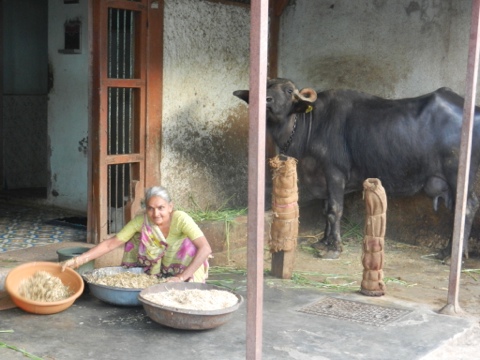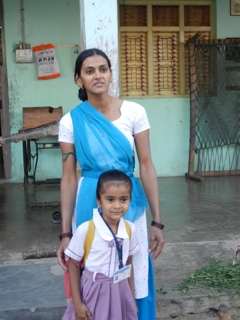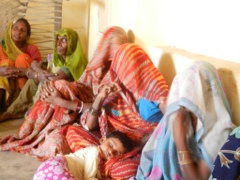
Over the past two days I have spent time in three villages of Mehsana district, in North Gujarat, where the RBS Foundation has been working over the past 5 years.
In this district, the work of our Foundation from 2007-11, focused primarily on the development of Pani Panchayats, or Participatory Irrigation Management (PIM), in 90 villages, covering a command area of 26,000 hectares. This area is irrigated by waters from the Dharoi Dam on the River Sabarmati. Though the project was built in 1979, many villages in the command area had no access to water, due to poor water management. The project sought to introduce a co- operative approach to the management of the Dharoi Dam waters both within villages and between villages at the Head and tail of the canal. The project also sought to improve access to drinking water and enhance Agricultural Productivity in these 90 villages.
Given the tremendous success of this project, which along with similar projects in Gujarat, has been dubbed the “blue revolution”, we extended the Project to a second phase 2011-2015. While continuing to support PIM, the project was extended to redress Gender Balance issues ( and therefore provide incremental income sources to women), enhance Capacity building and market linkages, and develop local value chains through Kisan/ farmers clubs.
Each of the villages I visited, though not more than 50-60 kms apart was very different from the other, and provided an interesting insight into the Gujarat of 2012.
Kesimpa, the first village I visited, was both the most affluent and the most progressive.
The village comprises of Shia Muslims and Hindus from the Rabari community. Residents were proud of the fact that there had never been a communal incident in their village. I stayed in a Muslim Mohalla and received the most extraordinary hospitality and affection. All the children were well educated,(including several going to English medium schools) They also received religious education in Urdu, at the village Madrassa to which I was welcomed in the morning.
The women of this village rise at 5, milk their cows and buffaloes, then work in the farms all day. Many of their men folk work elsewhere in the country or in the Middle East as construction labour. To supplement their incomes we introduced them to vermiculture which they adopted enthusiastically. They have now become Resource guides and consultants to our other villages. They have also all started small vegetable gardens, for their own consumption, with modest surpluses being sold commercially.
Each house in the Mohalla had electricity, running water, gas connections for cooking, at least one mobile phone and toilets. 40% of the women I met had individual savings bank accounts, all of them had Post office savings and in addition they had formed a women’s savings co-operative society. Homes are of “Pucca” cement construction, cattle sheds are located opposite the homes, and farms which are typically quite small are 10-15 mins walk from their homes.
Marriages, which are arranged, take place as community weddings, thus reducing expenditure to approx Rs 5000 per wedding. Girls are encouraged to study till graduate and often post graduate level, and were well informed and confident. Security in the village was said to be very good – no one could recall any incident of theft or violent crime in recent memory.
Dedasan, the next vilage, by contrast was both much poorer and very conservative. Comprising mostly of the Darbari Rajput community, women observed Ghunghat, and would not speak in the presence of an older man.
Though Dedasan is located at the Head of the Irrigation project and receives adequate water, the soil is rocky and not very fertile. Life is clearly hard, as could be seen from the weathered complexions of its residents. Though it also has 24×7 electricity, Dedasan has no piped water, no gas connections and only 10% of the homes had toilets. Approx 30% of the women I met, had mobile connectivity.
Homes are more spread out and range from cement, to mud to temporary straw construction. Cattle are kept in sheds on the farms.
Women have taken to vermiculture but have hesitated to adopt other value addition activities such as grading, sorting and packing the spices they grow – because they simply feel they cannot cope.
They want to save but have no access to bank or post office accounts. There are no hospital facilities with the nearest hospital 25 Km’s away. Road access to the village exists, but no regular bus service, and autos are quite expensive. There is great dignity about the people, but you sense their fatigue and weariness.
Karbatiya, the third village is relatively prosperous but not as homogenous or receptive to ideas as the other two. The village is divided along caste lines, and though relations are harmonious, there is little agreement on matters of collective importance.
The mindset is commercial and favours individual enterprise. The village therefore has 4 milk dairies (as opposed to 1 in most other villages). It also supports a Reverse Osmosis water purification plant, set up by a village entrepreneur named Raju Bhaiyya, at a cost of Rs 375,000. He has been provided land by the village Panchayat, in return for which he has undertaken to provide purified “mineral water” at Rs 6 for 20 litres. At an average cost of Rs 180 per household per month, villagers find this well worth their while, for the water has a fluoride content which leads to joint pains, and of course, it saves the time and expense of boiling water.
Here also homes were of cement construction, had 24×7 electricity, gas, mobile connectivity and toilets. The village is very compact, with homes close together, and cattle sheds either in front of or behind the home. Farms surround the village and land holdings are on average larger than the other two villages.
Bus access to the nearest town was good, and several young girls joined me on the bus ride to their college in the morning. ( the state provides free bus transportation to rural girls going to school or college)
There has been both inward ( people retiring and returning home) and outward (young people leaving for better job opportunities) migration from the village, and most of the young people I spoke to were looking for a way out. Though a fertile, irrigated area, there was little interest in the younger males to take up farming.
If I were to summarise my observation of the Mehsana district, it would be that while development has been impressive, not everything is shining. There are clear areas of success which the rest of the country can learn from; equally there are areas that would benefit from attention. These are shared below :
Clear Success Areas :
- the Co-operative mentality seeded by the white revolution of Anand, which has provided the foundation for collective effort in other areas eg water management
- the Jyoti Gram Yojna which has provided electricity to most villages in Gujarat, and the good discipline of charging for electricity both for agricultural use (Rs 7 per unit) and domestic rural consumption (Rs 4 per unit)
- the PIM which has led to greater water security both for agriculture and human consumption
- the excellent infrastructure to support Dairy and animal husbandry which provides a sustainable source of livelihood to supplement agriculture
Areas that could benefit from attention :
- though villages in this part of Gujarat are clearly prosperous, like many of our towns, development has been haphazard. Though homes inside are very clean, Common village areas in all three villages were dirty and dusty. No one seems to take accountability for village hygiene. The planting of trees and flowering plants; segregated areas for storage of dung; and emphasis on providing toilets to each home could make a world of difference.
- Though Gujarat has tackled its power situation admirably solar energy should be encouraged at least for street lighting, solar cookers and geysers.
- Insurance for dairy animals is widely used. However farmers have no faith in the current Crop and weather insurance – there is an opportunity for insurance firms to fill this gap
- In this small sample survey, women reported the incidence of Caesarian deliveries being as high as 80%. If representative of a larger population this requires serious attention.
My next destination is the Sabarkantha district in Eastern Gujarat. This is a tribal district with poor access to irrigation facilities, and therefore dependant on the vagaries of the monsoon. It will be interesting to see and understand the development model here.


http://meerasanyal.wordpress.com/2012/03/22/villages-of-mehsana/
No comments:
Post a Comment